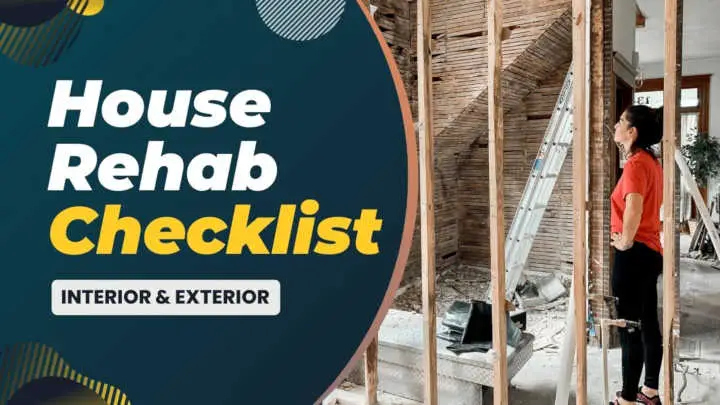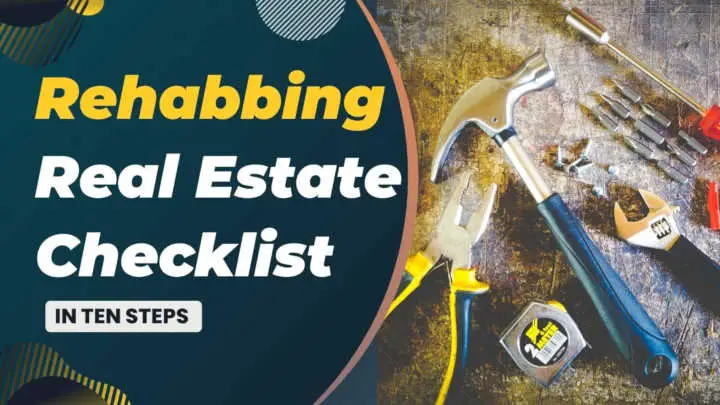In this article, I will share ten proven steps for rehabbing real estate in your local area and how to make a good profit out of it. But first, let me tell you it’s a business, not a quick fix. You have to do everything an entrepreneur does, like finding a good deal, doing all the marketing, negotiating with the seller, and creating a great plan to ensure you make a profit.
As this rehabbing real estate business is booming, more and more people want to get in here. But only those will succeed, who knows how to play the game of rehabbing, evaluate the market condition, create a house rehab checklist, and improve the interior and the exterior with minimal cost. But first, understand what exactly rehabbing real estate is.
What is Rehabbing Real Estate?
Rehabbing a house means as an investor, you will use the fix-and-flip strategy to purchase undervalued or distressed homes at a below-market price. Then you will make repairs and improvements to resale the house with a profit within 3-6 months.
It is also called house flipping or fixing and flipping the house. You can also use it for the buy-and-hold strategy in the long term and generate rental revenue. You will do the rehab and all the improvement but will not sell it quickly. You will put it on rent and collect a rental income. In the future, if your business goal matches, you will sell it.
So you have both options, but before you choose one, you must set your goals. What you should do with the house you are about to purchase as the market condition will have an impact on the decision you make. Whatever you choose, you must follow these ten rehabbing real estate steps to make the most profit from both of them.
Read also: The Best US State to Flip a House
Table of Contents
1. Evaluate the Current Property Condition
Before making any offer to the seller, evaluate the local market condition with a qualified analyzer. Check the demand and supply, job market, and population growth in the area.
And then focus on the structural and mechanical items of the house that are costly to repair, such as foundation and roof, flooring and insulation, walls and ceilings, air conditioning and heating system, and plumbing and electrical.
Why the market comes first? Because the market is everything when investing in real estate. A house can not give you profit if you choose the wrong market for it. So, first, the market, then the house itself.
2. Calculate Your Offer Price
Your offer price will depend on how you will make a profit. The seller will always try to sell it for future market value, which is far away. But you will deal with it at the current market value.
For example, the seller says this property will be worth $100,000 in the next five years. But today, the current market value is $80,000, and the property needs a rehab which will cost you about $10,000. So according to the current market condition, you make an offer of $55,000 with more than $10,000 profit in mind.
Don’t fall for the future value, as the future is uncertain. Deal in the present and offer accordingly. If he refuses, dot hesitates to leave it. Remember, it’s better to leave 100 good deals than buy a bad one.
3. Create the Checklist for Rehabbing a House

A house rehab checklist only contains two things the interior and the exterior analysis. For the interior, analyze these things.
- Basement and Foundation
- Insulation and Paints
- All the Walls and Doors
- Flooring and Kitchen appliances
- Bedrooms and Bathrooms
- And all the Fixtures
For exterior rehabbing a house analyze these things.
- Roof and Window condition
- Outside Paints
- Driveway and sidewalk with the Gutter inspection
- Landscaping and Fencing
- All the utility connections (water, gas, electric)
- And all the other noticeable stuff
If you do this, you will have to spend less money on rehabbing the house. And you can also negotiate it with the seller to reduce the asking price.
4. Now Budget for The House
After you have done all the above, you will have an idea how much will it cost me to buy and repair, and most importantly, can I make a profit from it? Here you can use some computer software to calculate that and know all the PROS and CONS of the house by evaluating all the numbers. But still, if you have doubts or want to increase your profit by reducing your expenses, you can hire a good contractor.
5. Hire a Good Contractor
A contractor usually charges 10 percent of the total budget of the rehab. So, if the entire project cost is $55,000, the contractor will receive a fee of around $5,500. Investors who rehab homes look for contractors with experience in renovating homes, and their bid follows the rehab checklist and budget in detail.
But before you select a contractor, ask him these questions so that you know that that person can do the work accurately.
- What experience do you have here?
- For how long have you been remodeling homes?
- How many homes have you rehabbed to date?
- Do you have all the permits, licenses, and insurance?
- Tell me the cost estimate and timeline for this project.
Ask all these questions, and if you think that person is qualified enough, then only hire him.
6. Collect all the Permits
Before doing anything with a house, you need certain government permits, like the building code, local zoning codes, and other local municipality permits. Make sure you have cleared all of them before you start your rehab.
Because a municipality worker might inspect each stage of a rehab project to ensure that the work is done accurately and to code. If a rehab project is done illegally by not pulling permits, sellers must disclose this to the buyer when the home is being sold.
You, as an investor, must inquire whether any rehabbing or updating was recently done on the house and do they follow the law. You can ask your contractor. He will know what permits the municipality requires.
7. Let the Work Begin
If everything looks good, let the demolition begin. It includes removing any trash from the house along with broken doors and windows, appliances, cabinetry, and kitchen and bathroom items. Clearing the home in the first place makes a rehab project go smoothly and allows the worker to do the work faster.
8. Improve the Interior

As I have said earlier, what improvement does the home interior need? Like replacing the heating, ventilation, air conditioning systems, plumbing, walls, and doors. Plus, all the bathroom and kitchen fixtures such as cabinets, sinks, appliances, bathtubs, and showers.
Replace all that is not working or seems too old and can break soon. But remember, don’t spend extra trying to replace all the items. You must go along with your budget.
If your budget complies, you can replace all the electric lines, all flooring, carpets, lights, and ceiling fans. First, replace the most damaged ones and if possible, repair the half-damaged items.
9. Improve the Exterior
Begin with the roof, paint, windows, and siding with keeping the inside of the house secure. Home repairs often catch the attention of the neighbors, and prospective home buyers and tenants driving by will create an opportunity for you to sell if someone asks for it.
It will help you build a prospect list so that the property does not remain vacant for too long once the rehab work is done. Use this attention and generate leads during the exterior rehab.
10. Sell and Exit from It
Now it’s time to go marketing and sell it. Search for prospective buyers or tenants who expressed an interest when the house was being rehabbed. When selling the property, promote it using ads and other real estate marketing campaigns. That way, you will sell it faster.
Last Words
So that is everything you need to know when rehabbing real estate in your local area. In short, buy it in the current market condition and create a rehab checklist with the budget in mind. Then repair it and sell it for a profit. Good luck. Thanks for reading.

